
Brontomerus
Mighty legs, swift steps.
Period
Cretaceous
Length
Around 50 feet in length.
Height
Up to 14 feet tall at the shoulder.
Weight
Approximately 15,000 pounds.
Brontomerus was a large, plant-eating dinosaur that roamed the Earth millions of years ago during the Cretaceous Period. Known for its powerful leg muscles, it was capable of moving quickly compared to other dinosaurs of its size. Its fossils were first discovered in Utah, offering researchers insights into the diverse lifestyles of dinosaurs living in that region.
Diet
Brontomerus was a herbivore, primarily consuming a variety of plant materials. Its diet would have included leaves, fruits, and possibly small branches, which it could reach with its long neck.
Hunting
As it was a herbivore, Brontomerus did not hunt other animals. Instead, it foraged for plants, moving across different terrains in search of food.
Environmental challenges
Brontomerus faced challenges from changing climates, which could affect the availability of its food sources. It also had to be wary of predators in its environment, though its large size offered some protection. Natural disasters, such as floods and volcanic eruptions, may have further shaped its habitat and survival tactics.
Speed
Moderate; not exceptionally fast due to size.
Lifespan
Lived for around several decades.
First discovery
First fossils found in Utah, USA in 1994.
Fun Facts
- Brontomerus means 'thunder thighs' in Greek, a name given because of its unusually large hip bones.
- This dinosaur lived about 110 million years ago during the Early Cretaceous period.
- Brontomerus was discovered in Utah, USA, highlighting the rich dinosaur history of the American West.
- It was a plant-eating dinosaur, likely using its strong legs to roam the ancient forests and plains in search of food.
- Brontomerus is known from only a few bones, leaving much about its appearance and behavior a mystery.
- The strong legs of Brontomerus might have been handy for kicking predators or moving quickly over rough terrain.
- Brontomerus is thought to belong to the sauropod family, which includes some of the largest dinosaurs that ever lived.
Growth and Development
Young Brontomerus likely remained close to their mothers for protection. They grew rapidly in their early years to deter predators. Their growth involved developing strong leg muscles, crucial for supporting their massive bodies and aiding their mobility.
Habitat
Brontomerus lived in areas that were rich in vegetation, such as forests and floodplains. These environments provided the necessary resources for their survival, including ample food and water. The climate was warm, with periods of seasonal rainfall.
Interaction with other species
Brontomerus coexisted with other dinosaurs and large herbivores, which sometimes led to competition for food. Predatory dinosaurs might have targeted the young or weaker individuals. However, its size and strength allowed Brontomerus to form herds for mutual protection.
Natural lifespan
Individual Brontomerus could live up to 50 years in favorable conditions.
Reproduction
Brontomerus reproduced through laying eggs, likely in communal nesting sites. These sites were chosen for protection and proximity to food. Parental involvement might have included guarding the nests from predators during incubation.
Social behaviour
Brontomerus likely traveled in groups or herds for protection and social interaction. Herding behavior would have helped them locate food and warn of potential dangers. Social bonds among individuals might have played a role in their survival strategies.
Fossil locations
Fossils of Brontomerus have primarily been discovered in the state of Utah, USA. These sites provide valuable insights into the ecosystem dynamics of the region during the Cretaceous Period.
